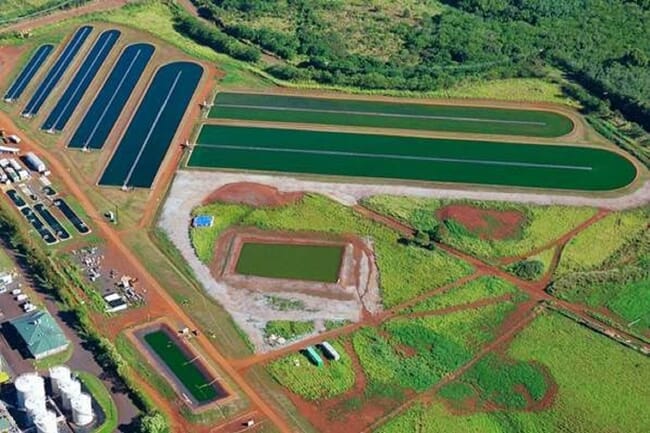
© Global Algae Innovations
The three-year project, which was announced by ISTC last month, aims to demonstrate that producing algae for commodity animal feeds can be cost-effective and has added environmental benefits.
Algae have been used for decades in the niche markets of health and beauty. A more recent focus is its ability to use CO2 from coal-fired power plants to make biofuels and protein-rich food products.
Algae is fast-growing compared with traditional terrestrial feed crops, so it’s an attractive alternative for use in taking up CO2 from power plants because it requires less land, according to ISTC principal investigator Lance Schideman. Researchers will use the Spirulina because it is already FDA approved for use as a food ingredient and has a high protein content, which commands higher prices.
The algae cultivation system will be integrated with the City Water, Light and Power plant in Springfield, Illinois. Schideman is collaborating with University of Illinois researchers Joshua McCann and Carl Parsons, who will conduct the animal feed studies. Global Algae Innovations will provide the algae biomass production system to be demonstrated at field scale for this project. The project is co-funded by the US Department of Energy National Energy Technology Laboratory.
In the past, ISTC scientists have researched wastewater algae systems that are now used at 10 full-scale operating wastewater plants. They’ve also been a leader in recycling the byproducts of hydrothermal biofuel production to enhance algal biomass productivity. Global Algae Innovations is a leading designer and equipment supplier in the algae industry that has developed and demonstrated cost-effective, large-scale algae production systems.
“We’re putting all the pieces together in a coordinated fashion and lowering the net costs of growing algae using industrial and municipal by-products as inputs to improve the economic environmental sustainability of algal carbon capture,” said Schideman in a press release issued by ISTC.
This approach reduces pollution and replaces the costly CO2 and nutrient inputs used in most algae cultivation systems. In the current commercial technology, managers buy liquid CO2 and various commercial fertilisers for the nutrient supply.
The wastewater, which is full of organic nutrients that support algae growth, will come from a local treatment plant.
“Using wastewater is a cost saving in the production process and it helps to solve problems that wastewater treatment plants are experiencing in trying to minimise nutrient discharges in the environment,” Schideman said. “In Illinois, the treatment plants are under increasing scrutiny, and regulations that are now voluntary are expected to become more stringent and potentially mandatory within the next decade.”
Ultimately, the system will produce feed especially for cattle and chickens. The product will be dry, which helps reduce spoilage, and will have a high nutritional value compared with some other feeds.
The typical price range for most bulk animal feed ingredients is $150–350 per ton, and certain high-value products can have a market value of $1,000–$2,000 per ton. Algae has the potential to command prices near the top of the range since some species contain highly nutritional components such as antioxidants and poly-unsaturated fatty acids. However, algal animal feeds are not yet established in the market, and the value of these products must be demonstrated through research studies like this one.
Schideman notes that the size of the animal feeds market is quite large and is a good match with the amount of CO2 produced by power plants around the country. Thus, using CO2 from flue gas in algae production has the potential to significantly reduce greenhouse gases.




